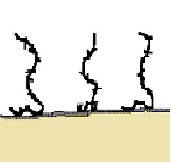
| Bovine submaxillary mucin | |||||||
|---|---|---|---|---|---|---|---|
| Identifiers | |||||||
| Organism | |||||||
| Symbol | BSM1 | ||||||
| UniProt | O62672 | ||||||
| |||||||
| May be part of a larger MUC19 gene, which corresponds to the porcine submaxillary mucin. [1] | |||||||
Bovine submaxillary mucin (BSM) coatings are a surface treatment provided to biomaterials intended to reduce the growth of disadvantageous bacteria and fungi such as S. epidermidis , E. coli , and Candida albicans . [2] BSM is a substance extracted from the fresh salivary glands of cows. It exhibits unique physical properties, such as high molecular weight and amphiphilicity, that allow it to be used for many biomedical applications.
Contents
- Physical characteristics
- Mechanical properties
- Chemical composition
- Interaction with surfaces
- Adsorption of BSM to solid surfaces and types of bonding
- Hydrophobic and electrostatic interactions
- pH dependence of adsorption
- Biocompatibility
- Tissue reactivity
- Prevention of adsorbing particles
- Applications
- Implant coatings
- Drug delivery systems
- Hydrogels
- See also
- References
Each species[ clarification needed ] possesses mucin-secreting submaxillary glands. Currently, eight different mucins have been identified for humans. [3] However, it is the mucin from bovine and porcine sources that have been used in several biomaterial applications. The most common use of BSM is in coatings for implanted materials. In such applications, the adsorption characteristics of BSM are integral to the behavior of materials in vivo. Survival and rejection of an implant are highly dependent on surface modifications that dictate the interfacial interaction between a material and the body. Thus, BSM adsorption increases biocompatibility.
Epithelial tissue lines surfaces throughout the body. A mucous gel layer composed of protein coats this tissue. The main function of the layer is protection from mechanical stress, dehydration, and bacterial infections. It also plays a role in cellular signaling, cellular interactions, and pH regulation. [2] The two main components of the gel are mucins and water, with the mucins forming the backbone of the mucous. [4]
Mucin originates from the mucus secretions from submaxillary glands, which are salivary glands that are located under the floor of the mouth. The secreted mucin assists in digestion by coating the bolus such that it travels easily through the digestive tract. Mucins are constituents of one class of glycoproteins: sialic acid-containing glycoproteins, or mucoproteins. [5] They have a high molecular weight and exist as either membrane-bound or secretory mucins. The membrane-bound type have a hydrophilic area that extends along a membrane and attaches to cellular surfaces. Secretory mucins are the main components of the mucous gel layer that coats the epithelium. [3]

